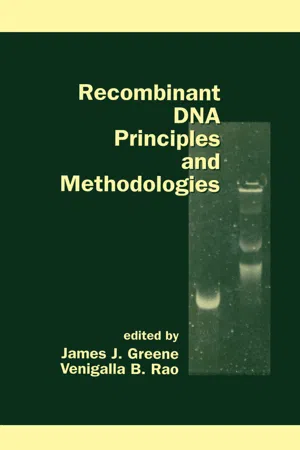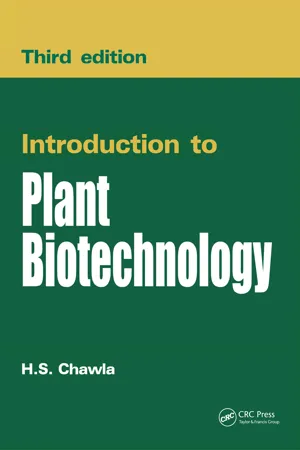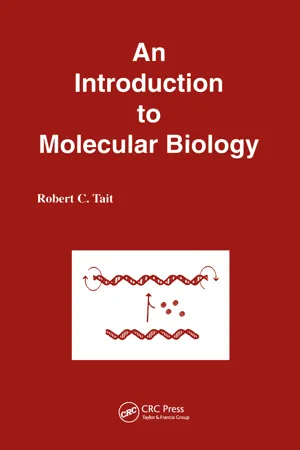Biological Sciences
Cosmid vectors
Cosmid vectors are plasmid vectors that can carry large DNA inserts, making them useful for cloning and studying large DNA fragments. They are derived from the combination of plasmids and bacteriophage lambda DNA, allowing them to accommodate DNA fragments up to 45-50 kilobases in size. Cosmid vectors are widely used in molecular biology and genetic engineering for their ability to handle large DNA fragments.
Written by Perlego with AI-assistance
Related key terms
Related key terms
1 of 4
Related key terms
1 of 3
5 Key excerpts on "Cosmid vectors"
- eBook - ePub
- James Greene(Author)
- 2021(Publication Date)
- CRC Press(Publisher)
12 Cosmid Cloning John Collins and Werner Lindenmaier National Biotechnology Research Center, Braunschweig, Germany I. INTRODUCTION A cosmid (Collins and Hohn 1978) is a plasmid cloning vector having one or more lambda bacteriophage cohesive end sites (cos), and capable of being replicated and selected for in an Enterobacteriacae strain which has lambda receptors, that is, maltose permease, the E. coli mal B gene product. Hosts are thus currently limited to E. coli or Salmonella typhimurium (Palva et al. 1981). Cosmid vectors have been optimized to take advantage of both the convenience of handling small vectors and the high efficiency of cloning 35 to 48 kb inserts using in vitro lambda packaging systems (Collins 1979, 1989; Collins and Brüning 1978; Collins and Hohn 1978; Collins and Lindenmaier 1983; Hohn 1979; Hohn and Collins 1980, 1988; Hohn and Hinnen 1980; Hohn and Hohn 1974; Hohn and Katsura 1977; Hohn et al. 1988; Hohn and Murray 1977). Cosmids have become a standard for the preparation of genomic libraries from the whole spectrum of living organisms, with publications too numerous to be cited here. They have become a central part of the genome mapping effort in combination with cDNA, lambda, P1, BAC, and YAC libraries (see other chapters of this book), and as has been pointed out recently (Schalkwyk et al. 1995), will remain a most convenient source of cloned DNA as one moves on from the physical mapping to answering the questions relating to the biological function of the identified gene sequences. The clones required for these functional studies will be rapidly and generally available from the ever-increasing number of ordered gene banks where the clones are kept in ordered arrays (Lehrach et al - eBook - ePub
Nonmammalian Genomic Analysis
A Practical Guide
- Bruce Birren, Eric Lai(Authors)
- 1996(Publication Date)
- Academic Press(Publisher)
7Cosmid Cloning with Small Genomes
Rainer Wenzel and Richard HerrmannI. Introduction
Cosmid vectors are useful tools for establishing gene libraries, as has been shown for a number of different prokaryotic and eukaryotic species, like the nematode Caenorhabditis elegans (Coulson et al. , 1986) or the bacteria Mycoplasma pneumoniae (Wenzel and Herrmann, 1989 ), Haloferax volcanii (Charlebois et al. , 1991), Mycobacterium leprae (Eiglmeier et al. , 1993), and Helicobacter pylori (Bukanov and Berg, 1994 ). Their cloning capacity of up to 51 kbp keeps the number of clones required for screening at a manageable range, especially when relatively small prokaryotic genomes have to be analyzed. Since, due to their size, transformation efficiencies of cosmids are rather low, introduction of cosmids into bacterial cells is usually done by in vitro packaging into phage λ particles followed by infection of the host cell. Though packaging efficiency of cosmids is not as good as for phage λ-derived vectors, the cosmids do have the advantage of containing high copy number replicons which give high yields of DNA.In the following, various strategies for the construction of an ordered set of cosmid clones representing a bacterial genome are discussed in general. As a guideline, the cloning of the entire genome of the bacterium M. pneumoniae in a contiguous set of cosmid clones is described (Wenzel and Herrmann, 1989 ). This small human pathogenic bacterium has a genome size of about 800 kbp (Wenzel et al. , 1992) which generally can be considered to be close to the lower limit of the coding capacity of a self-replicating cell (Morowitz, 1984 - eBook - ePub
- H S Chawla(Author)
- 2011(Publication Date)
- CRC Press(Publisher)
Cleavage at cos by the λ terminase protein during phage packaging produces a 12-nucleotide cohesive end at the termini of the linear λ genome. Recircularization of the λ genome after bacterial infection is facilitated by base pairing between the complementary cohesive ends. Cosmids were developed to overcome the technical problem of introducing large pieces of DNA into E. coli. Thus, bacteriophage cos DNA sequence was introduced that is required for packaging DNA into preformed phage heads. For successful packaging of DNA, there must be two cos sequences separated by a distance of 38–52 kb. Cosmid cloning vectors with DNA inserts of 30–45 kb can be packaged in vitro into λ phage particles, provided that the ligated double-stranded DNA contains λ cos sequences on either side of the insert DNA. Because the λ phage head can hold up to 45 kb of DNA, the optimal ligation reaction in cosmid cloning produces recombinant molecules with cos sequences flanking DNA segments of ~40 kb. Following adsorption of these phage particles on to suitable E. coli host cells, the cosmid vector circularizes via the cohesive ends and replicates as a plasmid. Cosmid vectors possess an origin of replication, a selectable genetic marker (antibiotic resistance), and suitable cloning sites. For this reason, cosmids are ideal vectors for genome mapping. Like plasmids, cosmids can multiply in large copy number using bacterial ori of replication (ColE1) inside the bacterial cell and do not carry the genes for lytic development. The advantages of cosmids are that (a) relatively large size of insert DNA (up to 45 kb) can be cloned; and (b) DNA can be introduced into the host using bacteriophages derived by in vitro packaging. The disadvantages are that (a) it is difficult to store bacterial host as glycerol stock; and (b) in vitro packaging is needed to maintain cosmids inside the viral heads. BACTERIOPHAGE VECTORS Bacteriophages are viruses that infect bacteria. These are usually called phages - eBook - ePub
- Alexander McLennan, Andy Bates, Phil Turner, Michael White(Authors)
- 2012(Publication Date)
- Taylor & Francis(Publisher)
The in vitro packaging of DNA into λ particles (see above) requires only the presence of the λ cos sites spaced by the correct distance (37–52 kb) on linear DNA. The intervening DNA can have any sequence at all; it need not contain any λ genes, for example. The simplest cosmid vector is a normal small plasmid containing a plasmid origin of replication (ori) and a selectable marker, and which also contains a cos site and a suitable restriction site for cloning (Figure 4). After cleavage with a restriction enzyme and ligation with target DNA fragments, the DNA is packaged into λ phage particles. The DNA is re-circularized by annealing of the cos sites after infection, and propagates as a normal plasmid, under selection by ampicillin. As in the case of phage λ (see above), more sophisticated methods are used in a real cloning situation to ensure that multiple copies of the vector or the target DNA are not included in the recombinant. Libraries of clones prepared with Cosmid vectors can be screened as described in Section Q3. The genomes of entire bacteria such as E. coli are available as a set of around 100 cosmid clones. YAC vectors The realization that the components of a eukaryotic chromosome required for stable replication and segregation (at least in the budding yeast Saccharomyces cerevisiae) consist of rather small and well-defined sequences (Section C3) has led to the construction of recombinant chromosomes (yeast artificial chromosomes; YACs). These can be used as vectors for carrying very large cloned fragments. The centromere, telomere, and replication origin sequences (Sections C3, D1, and D3) have been isolated and combined on plasmids constructed in E. coli. The structure of a typical pYAC vector is shown in Figure 5. The method of construction of the YAC clone is similar to that for cosmids in that two end fragments are ligated with target DNA to yield the complete chromosome, which is then introduced (transfected) into yeast cells (Section P3) - No longer available |Learn more
- R. C. Tait, R.C. Tait(Authors)
- 2023(Publication Date)
- Garland Science(Publisher)
Although restriction enzymes and DNA ligase can be used to specifically cleave and recombine chromosomal DNA fragments and generate new, recombinant DNA molecules, these capabilities alone are insufficient to allow isolation and characterization of genes. The ability to isolate the desired fragment away from other fragments and to amplify or increase the amount of the pure fragment are fundamental requirements of gene analysis. Both of these needs are provided by specialized helper DNA molecules termed vectors. These vector DNA molecules must be able to provide several specific biological functions to allow convenient propagation of the recombinant DNA molecules. Two properties in particular are crucial to the function of these helper DNA molecules. Vectors must be able to replicate in a host organism to produce many progeny copies of the recombinant molecule and must confer some new phenotypic property so that cells that contain the vector can be distinguished from cells that do not.Vectors are generally derived from naturally occuring extrachromosomal elements that are capable of replicating in a host (Table 6.1 ). Many vectors that function in bacteria have been derived from plasmids, small circular DNA molecules that encode various specialized genetic functions, or bacteriophage, such as lambda. The ability to replicate and produce many copies is an important function of the vector, for any DNA fragment that is inserted into the vector will also be replicated, making large quantities of the fragment relatively easy to obtain.Table 6.1 . Examples of bacterial cloning vectors.Vector Host Origin of replication Selection Features pUC19 E. coliColEl type plasmid Ampicillin General cloning gt10 E. coliBacteriophage lambda Plaques Insertional EMBL4 E. coliBacteriophage lambda Plaques Replacement M13mp19 E. coliBacteriophage M13 Plaques Single stranded pRK290 Gram−veRK2 plasmid Tetracycline Broad host range pHV15 B. subtilispC194 (S. aureus)Cloramphenicol Shuttle or E. colipBR322 (E. coli)Ampicillin Selection of vectors for various host cells
In addition to ability to replicate in a host cell, a vector must also contain a genetic marker that can be used to detect cells that contain the vector (Table 6.1 ). The most common selective markers present on plasmid vectors (Figure 6.1
Index pages curate the most relevant extracts from our library of academic textbooks. They’ve been created using an in-house natural language model (NLM), each adding context and meaning to key research topics.
Explore more topic indexes
Explore more topic indexes
1 of 6
Explore more topic indexes
1 of 4




